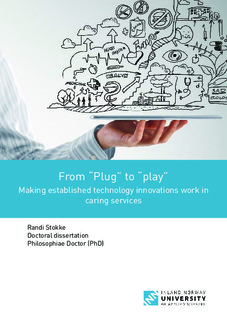From “Plug” to “play” : Making established technology innovations work in caring services
Doctoral thesis
Permanent lenke
http://hdl.handle.net/11250/2575152Utgivelsesdato
2018Metadata
Vis full innførselSammendrag
The overall aim of this article-based thesis is to develop the knowledge base of public
service innovations as a way of understanding established technology innovation in
municipal caring services. More precisely, the objective is to increase our understanding
of the complex reality of technology in use in caring practices by focusing on the
interactions between the technology and humans involved.
Policy documents describe a demand for increased technology innovations in community
care services to meet perceived challenges in the services caused by a “silver tsunami” and
to facilitate independent living. However, the integration of technologies has proven
to be difficult, and many projects never integrate into regular use after the pilot stage.
Research in the wake of these pilots seeking to identify drivers and barriers to technology
innovations in caring practices does not capture the technology innovations that
are actually integrated and used in regular caring practices, and what it takes to make
them work. To understand these public service innovations we need a knowledge base
incorporating the complex and diverse experiences with established technologies, and
an understanding of the interactions between people and the technology involved. This
thesis contributes towards a more comprehensive understanding of the “workings” of
technology innovations when exploring the social alarm, which is a widely established
and adopted technology innovation in caring practices.
Public service innovation is a developing field of exploring public services. More recent
public service innovation has mainly studied public innovations on an organisational
level. However, this thesis utilises the concept of co-production to explore the practice
of the social alarm in use on a micro level. The concept of co-production is further
developed by utilising aspects of science and technology studies as theoretical tools for
exploring public service innovations.
A systematic integrated review was conducted aiming to scope the research history of
the social alarm in use from a user perspective. Furthermore, a combination of participant
observations, 22 in-depth interviews and a study of documents related to the use
of the social alarm were conducted within the home care service in two municipalities
in Norway. Consequently, the thesis is based on descriptive and explorative qualitative
designs. The empirical data were analysed using a stepwise, deductive, inductive
method.
Through empirical analysis, the overall findings indicate the need to add theoretical
tools for understanding these innovations. By utilising the metaphor of script and
domestication from science and technology studies, this thesis contributes a theoretical
framework for exploring the co-production of expectations and experiences related to technology in use in caring practices. Thereby it further develops the understanding of
the field of public service innovation within caring practices.
This thesis demonstrates empirically how people involved with the social alarm utilise
the technology. The results describe complex and multiple caring practices with divergent
results related to its use. This promotes an increased understanding of how even
rather simple and well-established technologies are unpredictable and work differently
in different contexts when interacting with different people.
The focus is directed to efforts to make it work and to enable older people to live
independently and safely at home. The study also illustrates how technology innovations
change the dynamics between the people involved, rearranging caring practices, and
opening up for bricolages as an integrated part of established technology innovations.
